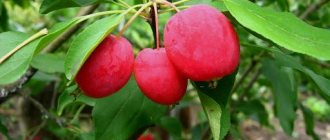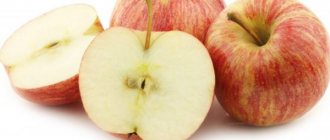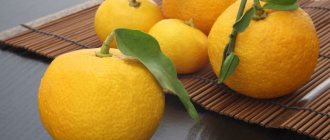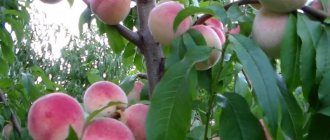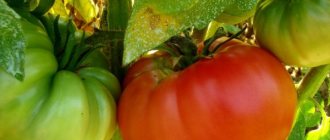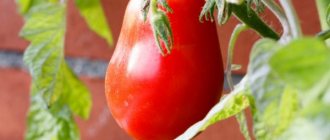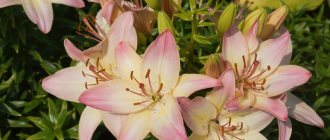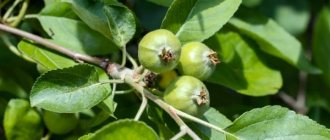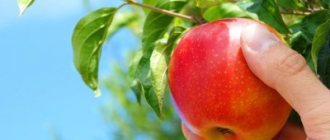Since ancient times, people have eaten wild apples. Small, sour fruits would not appeal to a modern person, spoiled by the benefits of civilization.
But apple trees have been domesticated. Apple growing dates back to Ancient Greece. Famous writers such as Pliny the Elder, Cato and others talked about 36 varieties.
In our country, the first apple orchard appeared in the 11th century, at monasteries. Gradually these trees spread throughout Rus'. Many varieties have been bred, with spherical fruits slightly larger than a pea and with huge ones, up to 15 cm in diameter.
The largest apples in the world are consumed both fresh and as dried fruit. By the way, the largest apple was grown by Japanese agronomist Chisato Iwasaki in 2005; its weight was 1.84 kg. And this was not an accidental victory, he had been working towards this for more than 20 years, tried different techniques and methods.
To get huge apples, gardeners feed seedlings, regularly graft trees, cross several varieties to get a new, especially productive one, or remove unnecessary ovaries on tree branches.
But, of course, the main secret is the correctly selected variety. We will tell you about the varieties with the most significant fruit size. Some of them grow up to 1 kg, and, interestingly, these giant apples are just as tasty and aromatic as other smaller ones.
Renet champagne, up to 150 g
One of the oldest varieties that came to us from Western Europe at the beginning of the 19th century. The tree begins to bear fruit at 6-8 years. They are arranged in bunches and hold very firmly. The harvest ripens at the end of September. Apples store very well, do not wither or wrinkle.
“ Renet Champagne ” produces fruits of rather large size, above average size, which weigh from one hundred to one hundred and fifty grams, yellow in color, but the sides are pink-red. Apples have snow-white, dense flesh; when the apple ripens, it becomes loose. The taste is pleasant, distinguished by sweetness, but with a slight sourness.
The sweetest varieties of apple trees
The taste of apples is determined by the sugar and acid content. Apples of the same variety in different climatic zones may have different sugar content.
In warm, sunny regions, apples accumulate more sugars. Thus, southern apples contain up to 10 - 11 percent sugar, while in the middle zone - 8 - 9 percent.
But some Central Russian apple trees have increased sugar content up to 12.5 percent.
For dessert apples, the coefficient ranges from 20 to 34, for sweet apples it is above 35.
Among the sweet-fruited trees there are both ancient and promising varieties of modern selection. Apples of old varieties from the people are often small and a little bland, and apple trees are distinguished by their tallness and frequency of fruiting.
But these apple trees are distinguished by amazing longevity and winter hardiness. Let's choose the best of them.
Korobovka
A traditional variety in gardens of various regions. Very resistant to unfavorable environmental conditions, diseases, and is characterized by unusually high resistance to low temperatures . Among the disadvantages are the long wait for the first harvest (7-8 years), small fruits (40-50g).
In the old days, these apples were sold in boxes, not kilograms. It is believed that this is where the name came from.
Very early ripening , apples ripen already in July. The pods are colored yellow-green with red veins and covered with thick skin. It sticks well to wood and doesn't last long - up to a month.
You can read more about the Korobovka apple tree here.
Nectar
Apples live up to their name. They emit a delicate honey aroma, contain up to 13 percent sugar and have juicy pulp, very tasty. The fruits are not very large, rounded - conical in shape, yellow with red, weighing 40 - 45g.
Apples ripen in August and cannot be stored for long periods of time. The trees reach medium height and tolerate frost and drought well. When mature, it may produce crops non-annually.
You can find out more about the Medoc apple tree here.
Arcade
Its varieties are yellow or white long. The fruits are quite sweet, but the trees themselves do not have good, stable yields.
The fruits are small, cup-shaped, yellow or pale yellow in color, and look impressive in a sparse, elongated crown. They ripen by the end of July - beginning of August , are not stored for a long time, and make good dried fruits.
Trees adapt well to difficult weather conditions, but are often affected by scab.
Read more information about the Arkad apple tree in this article.
Mironchik
In some regions it is known as Vyaznikovka, one of the most winter-hardy and durable.
Huge trees with a spreading crown reach a century of age and have average productivity and resistance to disease.
Late summer ripening variety
The fruits are small, have the shape of ribbed yellow cups with a speckled pattern and red strokes.
There is no acid in the taste, but there is a slight bitterness and a spicy aftertaste, which makes the apples very unique.
Candy
To develop the variety, Korobovka and Papirovka were crossed. The tree is still quite tall, which makes harvesting difficult. But the fruits have a very beautiful appearance; they have a scarlet color and even size. The weight of apples does not reach more than 100 g, but in general, the yield is very good. When bitten, tender and juicy.
You can wait 4-5 years for the first harvest, but then the harvest is annual and stable:
- The ripening of apples does not occur very smoothly, so the harvest period stretches throughout August;
- Picked apples can be stored for no more than a month.
You can read more about the Candy apple tree variety here.
Lungwort
The variety got its name due to its pronounced spicy, honey aroma. Received as a result of crossing the Cinnamon Striped and the Welsey. Apples:
- Round, slightly flattened;
- Yellow in color, densely covered with red stripes;
- The weight of the fruit reaches 100g;
- The pulp is juicy and tender.
Removable ripeness occurs at the end of August; apples can be stored for two to three months , but during storage the aroma and unique taste are significantly lost. It begins to bear fruit 4 years after planting and achieves maximum yield by 8 years of age. In adulthood, some periodicity of fruiting is noted.
You can find out more about the Medunitsa apple tree variety here.
The sweetness of scarlet
The trees are beautiful, not very tall, winter well, and produce crops quickly and efficiently. In unfavorable weather they may become affected by scab. They ripen in the first month of autumn, but are stored for no more than two months.
Bright scarlet apples weighing 70-80 g with thin skin, delicate pulp, without sourness. The variety is very good for baby food.
Cypress
Obtained by crossing Cinnamon Striped and Slavyanka. The variety ripens early in summer. The trees are quite tall with a beautiful crown and small fruits (up to 60g) of a whitish color, with a cover pink color in the form of stripes.
The taste of the fruit is very sweet, slightly spicy , the flesh is white, tender, quite juicy. The sugar-acid ratio is 46.
The variety is resistant to scab and provides good yield.
You will learn more about the Cypress variety from this article.
Orlik
A variety for winter storage, under favorable conditions it is stored until February. Medium-sized trees with a compact, rounded crown.
Yellow fruits with a purple barrel reach a weight of more than 100g. The pulp is dense, fine-grained, slightly creamy in color with a fairly strong odor and pleasant taste. When you bite into it, you feel a slight sourness , the sugar content is 11%.
You can read more about the Orlik apple tree variety here.
Belarusian sweet
Medium-sized trees with a sparse crown, which begin to bear fruit early, provide good yields of fairly large apples weighing up to 200g. The variety is late winter, ripens at the end of September and is stored until February.
The fruits are very beautiful - golden, red-sided. Apples have an oily pulp and a delicate, non-sour taste.
You can find out more about the Belarusian Sweet apple tree variety here.
Renet Simirenko
Apple trees are tall and spreading. The apples are light green in color with slightly noticeable specks. The aroma is pronounced, the taste is sweet, and contains up to 12% sugar.
autumn ripening variety reaches removable ripeness by the end of September, apples are stored until June.
Read more information about the Renet Simirenko apple tree in this article.
Melba
Apple trees are short and easy to care for. Fruit:
- Weight 150g and above;
- The shape is round, slightly flattened;
- Color yellow-green with red;
- The pulp of the fruit is juicy, with a candy aroma, snow-white, and fine-grained consistency.
Despite the summer ripening period, apples are not prone to rapid shedding, are well transported and are stored for at least 4 months.
You will learn more about the Melba variety from this article.
Children's
Trees of medium height with a dense crown. They begin to produce crops in the 5th year from the moment of planting. It lives up to its name, as its fresh-sweet taste and pleasant candy aroma .
The fruits are light, round, medium-sized and ripen by early September. Inside, the fruits are light, juicy, and slightly loose. The taste is rated 4.5 points.
The variety winters well and provides consistently good yields.
You can read more about the Children's apple tree variety here.
Qandil Sinap, 150-170 g
Crimean variety with vigorous trees. “ Qandil Sinap ” was once considered one of the best. The harvest appears in 12-15 years. Apples become ripe in late summer or early September.
Fruiting occurs once every two to three years, producing harvests for more than fifty years. One tree can produce up to 200-300 kg. The fruits are particularly tender, beautiful, but difficult to transport. They can be stored almost until the New Year, then if you keep them at a temperature of 2 degrees, then until the end of spring.
The fruits are cylindrical in shape and can weigh up to two hundred grams, but on average - from 120 to 145. They are green in color, but with a bright red blush. Gradually, during storage, they become yellow. The pulp is tender, tasty and juicy.
The largest apples
Tsar apples are obtained from the entire tree or from a specific branch, experienced gardeners say. The latter is preferable, since otherwise it will negatively affect the yield of the entire tree.
Fruit scientists have conducted a lot of research to determine the number of leaves that are necessary for a single giant fruit to grow. It turned out that a regular apple needs at least 40 leaves. But for the record holder there should, of course, be much more. However, some other factors of development and growth also play a role. For example, the number of branches and buds on one branch.
Winter banana, up to 200 g
Trees of this variety grow quickly (up to four meters), produce apples in the fifth or sixth year, and delight with harvests every season. Up to 200 kg of apples are harvested from a 15-year-old apple tree. Each of them weighs from one hundred fifty to two hundred grams. They are flat-round or oblong-conical in shape, light yellow in color, covered with a reddish blush with a pink tint.
The pulp of Winter Banana is also yellow, coarse-grained, and dense. It is juicy and sweetish. Apples smell delicious, the smell is banana-like. They ripen at the end of September and do not spoil until January.
Who grew the biggest apples
And this is not the first successful result of Iwasagi’s gardening activities. Chisato has already put the “production” of anomalous apples on stream. The man says he takes care of his trees like little children. Regularly measures soil temperature and humidity, prepares all kinds of fertilizers for apple trees, makes grafts and crosses. Well, for better results, the gardener leaves only a few fruits on one apple tree.
By the way, in Asia, huge apples are called Buddhist apples. This is because before selling, breeders put an image of Buddha on them. Only after this are the fruits sent to China for export. However, compotes are not made from these and they are not eaten for dessert. In the Celestial Empire, a Buddhist apple is considered an excellent gift, which is presented to respected people. And not only the weight of the apple is a record, but also its cost. A kilogram of fruit sometimes costs more than a thousand dollars.
Melrose, up to 500 g
The variety appeared in 1944. This is a vigorous tree with huge fruits. Their weight is over 190 g. They are yellow with a green tint, covered with a dark blush of bright red color. The pulp is particularly dense, juicy, light cream color, and sweet.
" Melrose " begins to bear fruit in 3-7 years and produces apples annually. A ten-year-old tree can produce a harvest of up to 82 kg. Apples ripen by mid-autumn; in natural storage they can last up to four to five months, and in industrial storage – up to 7 months.
1st place – Aphrodite
This tree with fruits of sweet and sour taste does not attract microscopic and harmful pathogenic fungi - scab. Aphrodite is immune to a dangerous disease, and also has good frost resistance, despite its Greek heat-loving name.
They bear fruit and are not afraid of frost. Fruitful and easy-to-care apple varieties Read more
Aport, up to 500 g
One of the most valuable varieties of apples, common in the southern regions, is “ Aport ”. The apple tree grows up to 5-6 m in height, with a powerful crown up to 10 m. On average, apples of this variety weigh from 270 to 300 g, but individual specimens grow up to 0.6 kg.
They have red-green skin. The pulp is fine-grained, crispy, white, green, crumbly. Up to 150 kg of apples are harvested from an adult tree every two years.
The best large-fruited varieties
Apples are good, but big apples are even better! Why not grow giant fruits in your dacha and delight your guests or neighbors with wonderful fruits? We bring to your attention several varieties of foreign selection, which have respectable fruit sizes and are perfectly acclimatized in the temperate zone.
- Fuji apples. One of the best samurai varieties that were bred in Japan back in the 1940s. Its peculiarity is the unsurpassed taste, which comes from the Delicious variety, and also the smell from Janet. As a result of crossing, a good fruit will be obtained, the weight of which reaches 260 grams. The tree grows relatively tall, up to 6 meters, with a pyramidal crown. It bears fruit already in the 3rd year, and in the 5th year you can already collect more than 15 kg from one tree.
- Granny Smith apples. “Granny” Smith was brought to Europe in the mid-19th century. Its homeland is New Zealand and Australia. There it was obtained as a result of crossing a wild forest apple with “domestic” varieties, and this happened by accident. Now Granny apples are extremely popular all over the world, and the delicious fruits, which reach 380 grams, confidently occupy a leading position in the markets.
- Ranet apple variety. It is considered one of the highest yielding in Russia. It was originally bred in China (therefore often called the “Chinese apple”), after which it began to be cultivated in the Volga region and Astrakhan. Fruit weight is up to 350 g, the average is 150 g. The taste is poor, you should only eat it at the stage of technical ripeness, they ripen quickly and disappear during long-term storage of apples.
Growing large fruits is not so easy, since the immunity of these plants is far from the best. They need to be sprayed several times a year with insecticides, and also ensure that the fungus does not attack. If you rarely care for plants, then this option is clearly not suitable for you.
Renet Pizguda, 500-700 g
An ancient variety of apples, which was mentioned by the Ukrainian fruit breeder Lev Platonovich Simirenko. “ Renet Pizguda ” has huge apples, each of which weighs from 500 to 700 g. They are considered highly dessert.
Minus - they are considered self-sterile. It requires pollinators, which can be Korey, Kuban spur and others. This variety is loved by many experts because... it is drought-resistant, begins to bear fruit early, produces a huge harvest, the fruits are very tasty, they are stored for a long time.
Conditions for the appearance of large fruits
After years of trying to grow large apples, gardeners began to notice patterns emerging.
So, according to professionals, the biggest fruits appear when the following conditions are met:
- The apple tree must be young. The best age for picking the most impressive fruits is considered to be from 2 to 5 years. After five years there is a decrease in size.
- Although massive fruits can be grown throughout the tree, it is preferable to allocate a few branches to them and knock down or cut off the rest. This way the apples get more nutrients, gain weight faster, and taste better. If you try to grow a record-breaking fruit and at the same time harvest a decent harvest, then both ideas will fail - the plant’s resources simply will not be enough.
- After numerous studies by fruit growers, it was found that for the normal development of the average apple, 40 healthy leaves are needed. But for a giant fruit, more than 160 may be required.
- Gardeners note the best results when growing one apple on a branch.
- Large fruits should be tied up, otherwise they risk not growing to record levels. Huge fruits simply fall, breaking thin apple tree branches with their weight.
Bellefleur-Chinese, 600-700 g
This variety was bred in our country in 1908, the first apples ripened in 1914. The quality of the fruit is one of the best. The fruits are slightly flattened, quite large, weighing on average 200-300 g, but there are also some very large specimens, weighing more than 500 g.
The apples are light green in color and lighten when ripe. Almost half covered with blush, pink-red. The pulp of " Bellefleur-Chinese " is fine-grained and white. The taste is sweet and sour, with a spicy aftertaste. The fruits are large, with a delicious dessert taste.
The tree itself grows 6-10 m and begins to produce the first apples at 8-9 years. The harvest ripens at the end of summer, is stored for about 2 months, and can last in the refrigerator until January. An adult tree produces about 50-70 kg of apples per year, every season. Apples are eaten fresh, fruit salads are prepared from them, jams and compotes are made.
4th place – Medunitsa
A child of two varieties (Brown Stripe and Welsey), obtained by Doctor of Biological Sciences S.I. Isaev in 1935. The fruits have a honey taste and the sweetest aroma. The small fruits may remind you of ranetki, which is why the variety is also called Honey ranet. The tree can be of two different varieties: winter or summer. The first bears fruit in late October - November, and the second - at the end of August. In the fourth year of growth, the tree begins to bear fruit; on average, it can produce 75–90 kg of plump reddish-honey apples.
Jumbo Pomm, up to 1 kg
This tree of French selection is one of the largest-fruited varieties of apple trees. It is unpretentious to conditions and does not require detailed pruning. The name “ Jumbo Pomm ” comes from two French words: “pomm” - apple, and “Jumbo” - that was the name of the baby elephant from the cartoon.
The tree itself is vigorous, with a powerful crown. It has very large, rounded-angular fruits of burgundy-red color. They weigh about 360 - 400 g, but there are individual specimens weighing up to 1 kg. The pulp is sweet, smells nice, very tasty. If the apple is overripe, it will be loose.
Apples should appear in 3-4 years, the harvest is annual. Apples ripen in September - October, but they should be eaten later, about a month later. If you store them in a cool place, they can last until spring.
0 0
3rd place – Melba
First, the Australian Nellie Melba masterfully performed the most complex opera roles of Verdi and Donizetti, became a Commander and Dame Grand Cross of the Order of the British Empire, and then a variety of apple tree was named in her honor.
In the first decade of its life, the tree can produce 85–100 kg of harvest. Then the apple tree matures and begins to take periods of rest, but again returns to the stage with an enchanting performance - a harvest of up to 50 kg.
Truth and myths about the apple tree. Is it possible to repeat a productive year Read more
In a world of giants
The apple is, without a doubt, a very popular fruit since antiquity. Let us just remember the bone of contention that led to the Trojan War, and the phrase itself has long become a household word. In modern Britain, there is even a holiday dedicated to the fragrant fruit.
Is it any wonder then to learn that in many countries there are sculptures representing giant apples? In the USA, for example, in addition to the crystal apple located at the entrance to the store of the famous Apple brand, several more monuments were erected at different times in honor of the country’s favorite fruit.
In Russia, apples are also held in high esteem. One of the sculptures is located in the center of Kursk as a tribute to the local Antonovka variety, which was delivered from here to the table of Catherine the Great. The weight of the monument is 150 kg, perhaps this is not the largest apple in the world among sculptural images, but, you see, it is also impressive.
Weight record holders
The world saw several of the largest apples thanks to the hard work of Chisato Iwasagi from Japan.
According to the gardener, he treats his trees like children, providing them with the best care. In his work and fruit growing, he uses not only the usual time-tested fertilizers and manipulations, but also modern technologies.
Chisato Iwasagi lives in Hirosaki and is 35 years old. He devoted most of his life to growing fruits - he has been doing this for about 20 years! It is not surprising that his apple trees produce giant fruits that can surprise anyone.
The record size apple, grown by a hardworking Japanese, weighed almost 2 kg, to be more precise, in 1849. It was picked from the tree and weighed on October 24, 2005. The second largest fruit was also Chisato's brainchild.
In an interview, Iwasagi admitted that he has to work hard to get such a large harvest:
- Measure soil temperature, humidity and acidity daily to maintain optimal parameters.
- Prepare your own fertilizers and fertilizers for your apple trees.
- Follow the technology for growing giant fruits, deliberately leaving no more than six fruits on the entire tree.
Naturally, Iwasagi does not share all his secrets, so as not to oversaturate the market with such an unusual product - the Japanese has made the creation of abnormally large apples his main profession. And it is in great demand, because a fruit weighing more than 1 kg can cost at auction no less than $1,000.
This price is due to the popularity of large apples; in Asia they are even called Buddhist apples. The name appeared because of an interesting custom: before selling a huge fruit, an image of Buddha is painted on the skin.
The “improved” fruit is exported to China, where the abnormal apples are considered an amazing gift for respected people. - businessmen receive them when concluding major transactions, and they are also presented when taking public office and even given at a wedding or request for marriage.
Huge apple | Big apple
Record-breaking apple chosen at Apple Fest in Almaty
10 MOST EXPENSIVE FRUITS IN THE WORLD
Official recognition
Despite all the exploits of Chisato Iwasagi in the field of growing the largest apple in the world, the official record belongs to another person.
The Japanese does not record the fruits of his labors in the Guinness Book, because he does not see the point in this: Chisato is far from wanting world fame. He goes about his life's work like a true samurai, without demanding worship in return.
The Book of Records includes the name of Alain Smith, who lives in the English city of Linton. Under natural conditions, he managed to grow an apple weighing 1674 g.
Now only memories remain of the past feat. However, the man, in order to always remember the large harvest, installed a huge statue of a bitten apple in his garden.
Decoding the dream depending on how big apples are cooked
- Baked with honey - for a pleasant acquaintance.
- Pickled - to news from close relatives.
- In compote - to complete an important task.
- Dried - to periodic mood changes.
- In a salad - to calm.
- Culinary decorations made from fruits mean the end of a bad period in life.
- As a filling for pies - to illness.
- Apple roll - for a fun party.
